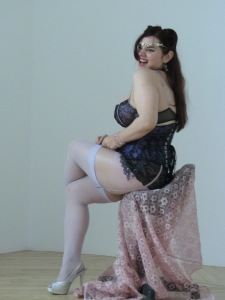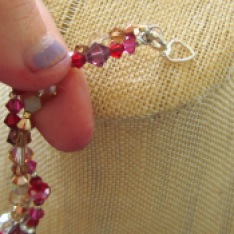Once Upon a Time,
There was a graduate student named Natasha Lee Q-T. She wanted to share the most beautiful revelation of her graduate school life with her peers and professors, so she wrote the following tale entitled:
Bringing Sexy Back: “Joining” in Cultural Experiences
I first arrive at the Boston Babydolls Dance Studio, soaking from the heavy rain pouring outside. With trembling hands, I clutch my purse tightly to my chest as a flock of nervously giggling girls in leggings and high heels emerge. Everyone appears giddy with anticipation. At 8pm, the door to room 208 opens, revealing a small, mirrored dance studio where the course instructor, Miss Mina, welcomes us into her domain.
“Which one of you is Natasha?” Miss Mina asks.
I raise my hand sheepishly and walk into the room. The door closes behind me. Having had a personal interest in burlesque and gender studies, I have chosen to observe this dance studio as an intern in the cultural psychoanalysis program, but my intention of merely “observing” begins to change as the prospect of joining the dancers becomes more enticing.
Miss Mina hands me an attendance sheet, and I nervously open the door and ask all of the other students their names. Miss Mina turns on some music, as I stand in the corner holding onto my notebook for dear life. I really want to be in this class – to dance with the other students – to learn burlesque. But that idea seems so far from reality that the mere concept makes me feel faint, and my heart flutters as Miss Mina approaches me.
She asks, “Natasha, would you like to participate in the class with the other students? Most of our interns like to participate in the beginning burlesque class.”
I feel myself blushing as I consider the prospect of dancing. I remind myself that I am here as a researcher, but then again, “joining” is utilized as a modern psychoanalytic approach… to the distaste of many contemporary academic disciplines! While the most respected researchers in anthropology, sociology, and “modern” psychology only ascribe value to data collected through detached, empirical, “objective” observation, psychoanalysts believe that participant observation is still a worthy pursuit. Although experts in various fields insist that subjective research methods like this are “archaic,” “naïve,” technologically “primitive,” and “biased” by participation, I began to wonder… Could one also be “biased” by lack of participation – especially because the concept of “objective” empirical research implies a hierarchical, superiority-based privileging of observation versus direct experience? It simply assumes that a researcher is the superior authority on culture – rather than those who live within it! Standing there lost in my thoughts I realize that in order to truly understand the psychological dynamics behind burlesque theater, I need to immerse myself in burlesque culture. And I am absolutely thrilled, and terrified.
With an electric shiver of excitement mixed with fear I stutter, “B-but… I… I don’t have any high heels or gloves. Are you sure I can be in your class?” Being a studious young lady, I had read the class description online before attending – and I knew that gloves and heeled shoes would be part of the lesson plan.
“It’s fine,” Mina replies. “I have some extra gloves you can borrow for now.”
A moment of panic washes over me. I have always loved performance art and dance, yet I have little experience as a dancer, and sometimes, I find myself to be a bit clumsy. My hand-eye coordination is weak, and I feel ill with trepidation…
Somehow I manage to gather enough courage to forget every insecurity I have about my body and my ability to dance. I forget that I am a chubby, short girl, and I feel a bizarre empowerment wash over me. So what if these other girls see me naked? No matter what, I’m seeing them naked… And some of them are even chubbier than I am! Besides, burlesque dancers never take off all of their clothes anyhow – it’s really just the equivalent of wearing a rather skimpy bikini…
Still reeling with panic, I manage to mumble, “Okay, I’ll join you.”
Standing there in front of the mirror, I become hyper-aware of my curves, my facial expression, my posture. A mirror can really intimidate a novice dancer by echoing each of your mistakes on its surface and revealing every false move to spectators. I cannot meet my own eyes in the mirror. Again, I am trembling violently, and as the music begins, the pounding of my heart becomes a roar in my ears.
Adrenaline fills my body, energizing me for a “fight or flight” response to this tremendously daunting task. As we begin warm-up exercises, I feel my face turning pink as I blush – I cannot help but giggle almost continuously – and a huge smile appears on my face in the mirror.
Am I actually enjoying this? Yes, very much! In fact, I feel as if a new sense of purpose and vitality is entering my body. Miss Mina’s voice interrupts my racing thoughts.
Miss Mina states, “The first important move you will learn in burlesque is the “bump.” Imagine yourself holding a big bag of groceries and exiting your car. How can you close the car door with your hands full? You can use your hip – like this!” Mina rapidly moves one hip up to the side, creating a sensuous curve with the side of her body. The entire class mimics her movements, and to my surprise I complete the maneuver with ease. Beaming with pride, I pretend I am balancing groceries on my hip while I close my imaginary car door – blowing an exaggerated kiss to myself in the mirror to thank myself for being such a good audience!
Mina continues, “The bump can be performed in four directions: right, left, forwards and backwards. The forward bump is similar to the “pelvic thrust” in The Rocky Horror Picture Show. It looks very suggestive – even lewd. But you will find that burlesque balances precariously between suggestive, erotic and sexual themes – as well as themes of innocence, coyness, and traditional female gender stereotypes. The perfect tease blend elements of both, hitting the “sweet spot” or harmony between two extremes. The result of this fusion is public display of female sexuality and eroticism that remains somehow veiled in a thin mist of propriety. Some of these dance moves – like the forward bump – are not what proper ladies do in public, but in burlesque they may be used sparingly to entice and insinuate. As women, we are told not to make such lewd gestures with our bodies, but I encourage you to overcome this social stigma to perform this dance move.”
{I am reminded of satyr plays… or satire. Burlesque, it turns out, is laced with the most addictive, decadent, rich and delicious satire – that I thought it only fitting to eventually name myself after my favorite sweet yet deadly desert… and Clarissa Cupcake was born. Unlike Venus, born of sea foam, I imagined myself born of frosting… and perhaps sprinkles! It was like an endless sugar rush without the cavities or health concerns}.
The “bump” move is easy for me to pick up, though the forward and backward versions of the maneuver were far more difficult to perform than the side-to-side motions. I laugh at myself in the mirror, realizing that I am effectively humping the air in front of me. It does not look particularly sexy to me, but my performance seems adequate. As we practice removing our gloves in various ways, I begin to feel more confident and poised, and I am amazed how well I can actually dance!
After the class, I glance in the mirror and find my own image smiling back at me. My cheeks glow with warmth, and I feel intoxicated with elation. As I look in the mirror I realize how long it has been since I have seen myself so confident and happy and wonder how I became so estranged from joy in my adult life. I feel alive, radiant, and absolutely ecstatic! Tired yet excited, I leave class with a renewed passion for gender studies and even more determination to expel gender prejudice through research.
Perhaps my experience offers the perfect example of the power behind “joining” as a psychological mechanism in group membership. If I had never allowed myself to join the burlesque fantasy, I would not have developed the strong relationship I now have with the Boston Babydolls. It just goes to show that even in the research world, you do not understand a person until you walk a mile in their shoes… or rather, in their favorite pair of glittery high heels (should they happen to be a burlesque performer)!
It is through this process of shedding my clothes that I began to understand what psychoanalysts refer to as “dialectics”, and Buddhists refer to as “the middle way”, and thousands of philosophers, poets, etc. etc. pay homage to in their great works.
And from this greater understanding of this awe-inspiring place – the verge, horizon, cusp, crossroads, transition, and edge between worlds and concepts, where borders merge and the haze gives birth to new and strange things – that the Chain Reactions concept eventually emerged. No longer afraid of change or fluidity, I became an obsessed devotee of modular and hybrid design.















